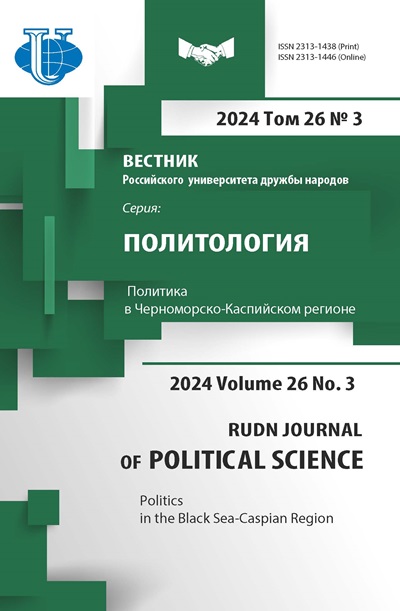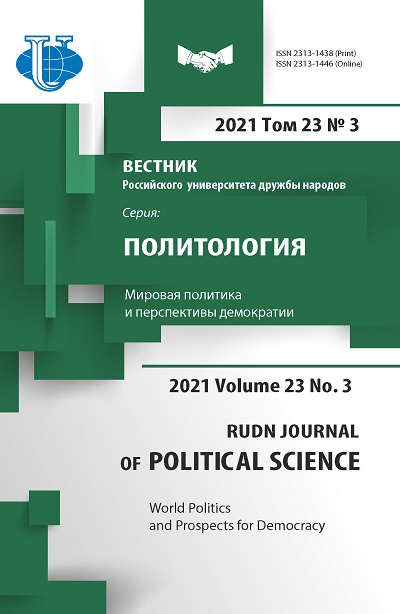Party Strength of Regionalist Parties of United Kingdom: Conceptualisation and Measuring
- Authors: Grabevnik M.V.1
-
Affiliations:
- Perm Federal Research Center of the Ural Branch of the Russian Academy of Sciences
- Issue: Vol 23, No 3 (2021): World Politics and Prospects for Democracy
- Pages: 463-478
- Section: PARTIES IN POLITICS: THE IDEOLOGY OF RADICALISM AND REGIONALISM
- URL: https://journals.rudn.ru/political-science/article/view/27309
- DOI: https://doi.org/10.22363/2313-1438-2021-23-3-463-478
Cite item
Full Text
Abstract
The article conceptualizes the concept of party strength and the measurement of its two quantitative elements (electoral and institutional) by example of four United Kingdom regionalist parties: Scottish National Party, Democratic Unionist Party, Sinn Fein and Plaid Cymru. Based on the analysis of the main theoretical approaches to party strength, the article proposes a method for its measurement, which can be used to measure and evaluate regionalism through the strength of regionalist parties in different political and institutional contexts. Comparing the levels of electoral and institutional party strength allows to highlight several tendencies: growth in electoral strength of UK regionalist parties during 2010s is noted, with stabilization of the institutional party strength; and the gap in the levels of institutional strength of the regionalist parties does not reflect the difference in the level of electoral strength. At the same time, the article mentions the challenges to assessing the strength of regionalist parties, namely, the need for detailed conceptualization of the qualitative characteristics of the party strength and the lack of analysis of the communicative and organizational elements of party strength.
About the authors
Mikhail V. Grabevnik
Perm Federal Research Center of the Ural Branch of the Russian Academy of Sciences
Author for correspondence.
Email: m.grabevnik@gmail.com
ORCID iD: 0000-0002-3321-7519
Сandidate in Political Science, Research Fellow
Perm, Russian FederationReferences
- Ananieva, E.V. (2017). Divided Britain. The Contemporary Europe, 5(77), 5–15. (In Russian).
- Panov, P.V. (2020). Many faces of regionalism. Bulletin of Perm University. Political Science, 14(1), 102–115. (In Russian).
- Blau, A. (2008). The effective number of parties at four scales: Votes, seats, legislative power and cabinet power. Party Politics, 14(2), 167–187.
- Chiocchetti, P. (2016). Measuring party strength: A new systematic framework applied to the case of German parties, 1991–2013. German Politics, 25, 84–105.
- De Winter, L., & Tursan, H. (1998). Regionalist parties in Western Europe. London: Routledge.
- Ignazi, P. (1996). The crisis of parties and the rise of new political parties. Party Politics, 2(4), 549–566.
- Katz, R., & Mair, P. (1995). Changing models of party organization and party democracy. The emergence of the Cartel Party. Party Politics, 1(1), 5–28.
- Massetti, E., & Schakel, A. (2016). Between autonomy and secession: decentralization and regionalist party ideological radicalism. Party Politics, 1, 59–79.
- Lijphart, A. (1985). Proportional tenure vs. proportional representation: Introducing a new debate. European Journal of Political Research, 13, 387–399.
- Rosema, M. (2006). Partisanship, candidate evaluations, and prospective voting. Electoral Studies, 25, 467–488.
- Rye, D. (2014). Political parties and the concept of power. A theoretical framework. Basingstoke: Palgrave Macmillan.
- Taagepera, R. (2007). Predicting party sizes: The logic of simple electoral systems. NewYork, Oxford University Press.
- Vowles, J. (2004). Electoral systems and proportional tenure of government: Renewing the debate. British Journal of Political Science, 34, 166–179.
















